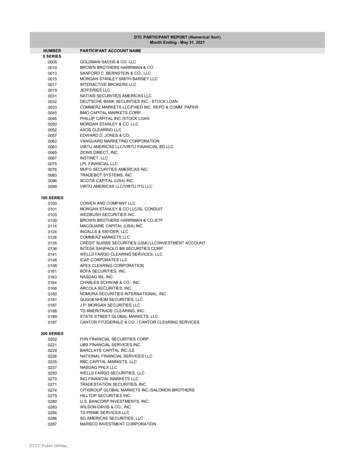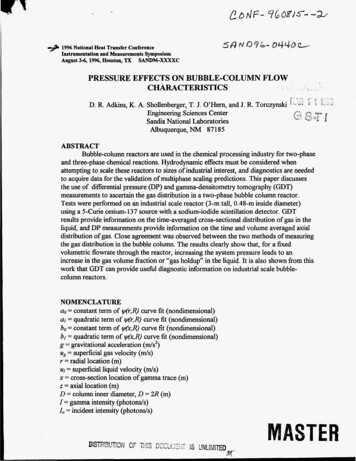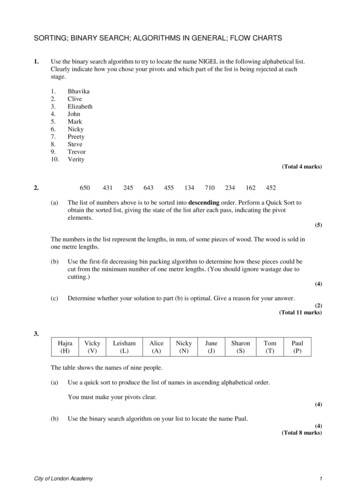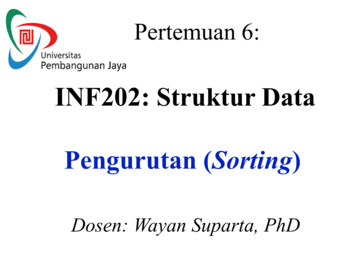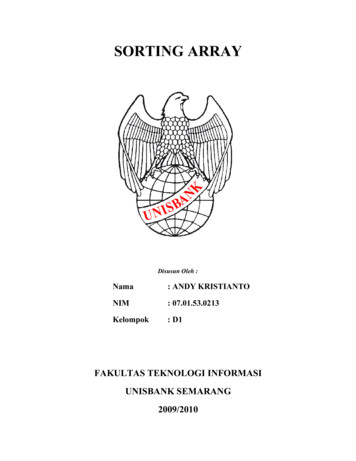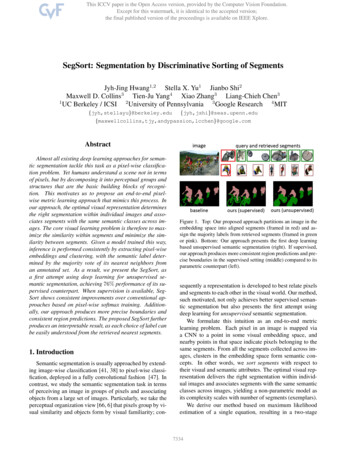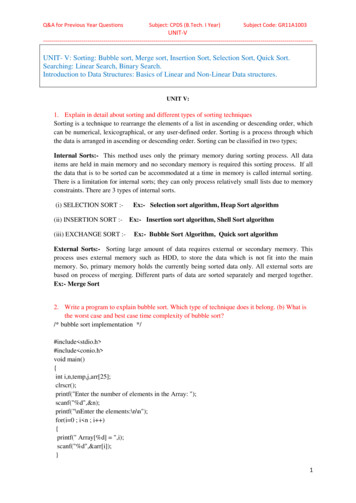
Transcription
Q&A for Previous Year QuestionsSubject: CPDS (B.Tech. I Year)Subject Code: NIT- V: Sorting: Bubble sort, Merge sort, Insertion Sort, Selection Sort, Quick Sort.Searching: Linear Search, Binary Search.Introduction to Data Structures: Basics of Linear and Non-Linear Data structures.UNIT V:1. Explain in detail about sorting and different types of sorting techniquesSorting is a technique to rearrange the elements of a list in ascending or descending order, whichcan be numerical, lexicographical, or any user-defined order. Sorting is a process through whichthe data is arranged in ascending or descending order. Sorting can be classified in two types;Internal Sorts:- This method uses only the primary memory during sorting process. All dataitems are held in main memory and no secondary memory is required this sorting process. If allthe data that is to be sorted can be accommodated at a time in memory is called internal sorting.There is a limitation for internal sorts; they can only process relatively small lists due to memoryconstraints. There are 3 types of internal sorts.(i) SELECTION SORT :(ii) INSERTION SORT :(iii) EXCHANGE SORT :-Ex:- Selection sort algorithm, Heap Sort algorithmEx:- Insertion sort algorithm, Shell Sort algorithmEx:- Bubble Sort Algorithm, Quick sort algorithmExternal Sorts:- Sorting large amount of data requires external or secondary memory. Thisprocess uses external memory such as HDD, to store the data which is not fit into the mainmemory. So, primary memory holds the currently being sorted data only. All external sorts arebased on process of merging. Different parts of data are sorted separately and merged together.Ex:- Merge Sort2. Write a program to explain bubble sort. Which type of technique does it belong. (b) What isthe worst case and best case time complexity of bubble sort?/* bubble sort implementation */#include stdio.h #include conio.h void main(){int i,n,temp,j,arr[25];clrscr();printf("Enter the number of elements in the Array: ");scanf("%d",&n);printf("\nEnter the elements:\n\n");for(i 0 ; i n ; i ){printf(" Array[%d] ",i);scanf("%d",&arr[i]);}1
Q&A for Previous Year QuestionsSubject: CPDS (B.Tech. I Year)Subject Code: r(i 0 ; i n ; i ){for(j 0 ; j n-i-1 ; j ){if(arr[j] arr[j 1]) //Swapping Condition is Checked{temp arr[j];arr[j] arr[j 1];arr[j 1] temp;}}}printf("\nThe Sorted Array is:\n\n");for(i 0 ; i n ; i ){printf(" %4d",arr[i]);}getch();}Time Complexity of Bubble Sort :The complexity of sorting algorithm is depends upon the number of comparisons that are made. Totalcomparisons in Bubble sort is: n ( n – 1) / 2 n 2 – nBest case:O (n2)Average case:O (n2)Worst case:O (n2)3. Explain the algorithm for bubble sort and give a suitable example.algorithm for exchange sort with a suitable example.(OR) Explain theIn bubble sort method the list is divided into two sub-lists sorted and unsorted. The smallest elementis bubbled from unsorted sub-list. After moving the smallest element the imaginary wall moves oneelement ahead. The bubble sort was originally written to bubble up the highest element in the list. Butthere is no difference whether highest / lowest element is bubbled. This method is easy to understandbut time consuming. In this type, two successive elements are compared and swapping is done. Thus,step-by-step entire array elements are checked. Given a list of ‘n’ elements the bubble sort requires upto n-1 passes to sort the data.2
Q&A for Previous Year QuestionsSubject: CPDS (B.Tech. I Year)Subject Code: gorithm for Bubble Sort:Bubble Sort ( A [ ] , N )Step 1 : Repeat For P 1 to N – 1Step 2 :BeginRepeat For J 1 to N – PStep 3 :BeginIf ( A [ J ] A [ J – 1 ] )Swap ( A [ J ] , A [ J – 1 ] )End ForEnd ForStep 4 : ExitExample:Ex:- A list of unsorted elements are: 10 47 12 54 19 23(Bubble up for highest value shown here)A list of sorted elements now : 54 47 23 19 12 104. Show the bubble sort results for each pass for the following initial array of elements.35 18 7 12 5 23 16 3 13
Q&A for Previous Year QuestionsSubject: CPDS (B.Tech. I Year)Subject Code: .Write a program to explain insertion sort . Which type of technique does it belong.(or)Write a C-program for sorting integers in ascending order using insertion sort./*Program to sort elements of an array using insertion sort method*/#include stdio.h #include conio.h void main( ){int a[10],i,j,k,n;clrscr( );printf("How many elements you want to sort?\n");scanf("%d",&n);printf("\nEnter the Elements into an array:\n");for (i 0;i n;i )scanf("%d",&a[i]);for(i 1;i n;i ){k a[i];for(j i-1; j 0 && k a[j]; j--)a[j 1] a[j];4
Q&A for Previous Year QuestionsSubject: CPDS (B.Tech. I Year)Subject Code: j 1] k;} printf("\n\n Elements after sorting: \n");for(i 0;i n;i )printf("%d\n", a[i]);getch( );}OUTPUT:How many elements you want to sort ? : 6Enter elements for an array :78 23 45 8 32 36After Sorting the elements are :82332 36 45 786. Explain the algorithm for insertion sort and give a suitable example.Both the selection and bubble sorts exchange elements. But insertion sort does not exchangeelements. In insertion sort the element is inserted at an appropriate place similar to cardinsertion. Here the list is divided into two parts sorted and unsorted sub-lists. In each pass, thefirst element of unsorted sub list is picked up and moved into the sorted sub list by inserting itin suitable position. Suppose we have ‘n’ elements, we need n-1 passes to sort the elements.Insertion sort works this way:It works the way you might sort a hand of playing cards:1. We start with an empty left hand [sorted array] and the cards face down on the table [unsortedarray].2. Then remove one card [key] at a time from the table [unsorted array], and insert it into thecorrect position in the left hand [sorted array].3. To find the correct position for the card, we compare it with each of the cards already in thehand, from right to left.INSERTION SORT (A)1.2.3.4.5.6.7.8.FOR j 2 TO length[A]DO key A[j]{Put A[j] into the sorted sequence A[1 . . j 1]}i j 1WHILE i 0 and A[i] keyDO A[i 1] A[i]i i 1A[i 1] keyExample: Following figure (from CLRS) shows the operation of INSERTION-SORT on the arrayA (5, 2, 4, 6, 1, 3). Each part shows what happens for a particular iteration with the valueof j indicated. j indexes the "current card" being inserted into the hand.5
Q&A for Previous Year QuestionsSubject: CPDS (B.Tech. I Year)Subject Code: ead the figure row by row. Elements to the left of A[j] that are greater than A[j] move one position tothe right, and A[j] moves into the evacuated position.Ex:- A list of unsorted elements are: 78 23 45 8 32 36 . The results of insertion sort foreach pass is as follows:-A list of sorted elements now : 8 23 32 36 45 787.Demonstrate the insertion sort results for each insertion for the following initial array ofelements. 25 6 15 12 8 34 9 18 26
Q&A for Previous Year QuestionsSubject: CPDS (B.Tech. I Year)Subject Code: . Demonstrate the selection sort results for each pass for the following initial array of elements. 21 6 3 57 13 9 14 18 27
Q&A for Previous Year QuestionsSubject: CPDS (B.Tech. I Year)Subject Code: ------------------------------------------------9. Write a program to explain selection sort. Which type of technique does it belong./* program to sort elements of an array using selection sort*/#include stdio.h void main( ){int i,j,t,n,min,a[10];clrscr( );printf("\n How many elements you want to sort? ");scanf("%d",&n);printf("\Enter elements for an array:");for(i 0;i n;i )scanf("%d",&a[i]);for(i 0;i n;i ){min i;for(j i 1;j n;j )if(a[j] a[min]){min j;}t a[i];a[i] a[min];a[min] t;} printf("\nAfter sorting the elements are:");for(i 0;i n;i )printf("%d ",a[i]);getch( );}OUTPUT8
Q&A for Previous Year QuestionsSubject: CPDS (B.Tech. I Year)Subject Code: w many elements you want to sort? :5Enter elements for an array :2 6 4 8 5After Sorting the elements are :8 6 5 4 210. Explain the algorithm for selection sort and give a suitable example.In selection sort the list is divided into two sub-lists sorted and unsorted. These two lists aredivided by imaginary wall. We find a smallest element from unsorted sub-list and swap it to thebeginning. And the wall moves one element ahead, as the sorted list is increases and unsorted listis decreases.Assume that we have a list on n elements. By applying selection sort, the first element iscompared with all remaining (n-1) elements. The smallest element is placed at the first location.Again, the second element is compared with remaining (n-1) elements. At the time of comparison,the smaller element is swapped with larger element. Similarly, entire array is checked for smallestelement and then swapping is done accordingly. Here we need n-1 passes or iterations tocompletely rearrange the data.Algorithm: Selection Sort ( A [ ] , N )Step 1 :Step 2 :Step 3 :Repeat For K 0 to N – 2BeginSet POS KRepeat for J K 1 to N – 1BeginIf A[ J ] A [ POS ]Set POS JEnd ForStep 5 :Swap A [ K ] with A [ POS ]End ForStep 6 :ExitEx:- A list of unsorted elements are: 23 78 45 8 32 569
Q&A for Previous Year QuestionsSubject: CPDS (B.Tech. I Year)Subject Code: -------------------------------------------------A list of sorted elements now : 8 23 32 45 56 7811. Show the quick sort results for each exchange for the following initial array of elements35 54 12 18 23 15 45 3812. Explain the algorithm for QUICK sort ( partition exchange sort) and give a suitable example.Quick sort is based on partition. It is also known as partition exchange sorting. The basic concept ofquick sort process is pick one element from an array and rearranges the remaining elements around it.This element divides the main list into two sub lists. This chosen element is called pivot. Once pivot ischosen, then it shifts all the elements less than pivot to left of value pivot and all the elements greaterthan pivot are shifted to the right side. This procedure of choosing pivot and partition the list isapplied recursively until sub-lists consisting of only one element.Ex:- A list of unsorted elements are: 8 3 2 11 514 0 2 94 2010
Q&A for Previous Year QuestionsSubject: CPDS (B.Tech. I Year)Subject Code: lgorithm for quick sort:It is also known as partition exchange sort. It was invented by CAR Hoare. It is based on partition.The basic concept of quick sort process is pick one element from an array and rearranges theremaining elements around it. This element divides the main list into two sub lists. This chosenelement is called pivot. Once pivot is chosen, then it shifts all the elements less than pivot to left ofvalue pivot and all the elements greater than pivot are shifted to the right side. This procedure ofchoosing pivot and partition the list is applied recursively until sub-lists consisting of only oneelement.quicksort(q)varlist less, pivotList, greaterif length(q) 1return qselect a pivot value pivot from qfor each x in q except the pivot elementif x pivot then add x to lessif x pivot then add x to greateradd pivot to pivotListreturn concatenate(quicksort(less), pivotList, quicksort(greater))Time Complexity of Quick sort:Best case:O (n log n)Average case:O (n log n)Worst case:O (n2)Advantages of quick sort:11
Q&A for Previous Year QuestionsSubject: CPDS (B.Tech. I Year)Subject Code: ------------------------------------------------1. This is faster sorting method among all.2. Its efficiency is also relatively good.3. It requires relatively small amount of memory.Disadvantages of quick sort:1. It is complex method of sorting so, it is little hard to implement than other sorting methods.13. Explain the algorithm for Merge sort and give a suitable example.The basic concept of merge sort is divides the list into two smaller sub-lists of approximatelyequal size. Recursively repeat this procedure till only one element is left in the sub-list.After this,various sorted sub-lists are merged to form sorted parent list. This process goes on recursively tillthe original sorted list arrived.Algorithm for merge sort:Merge sort is based on the divide-and-conquer paradigm. Its worst-case running time has a lowerorder of growth than insertion sort. Since we are dealing with sub-problems, we state each subproblem as sorting a sub-array A[p . r]. Initially, p 1 and r n, bu
The bubble sort was originally written to bubble up the highest element in the list. But there is no difference whether highest / lowest element is bubbled. This method is easy to understand but time consuming. In this type, two successive elements are compared and swapping is done. Thus, step-by-step entire array elements are checked. Given a list of ‘n’ elements the bubble sort requires .


